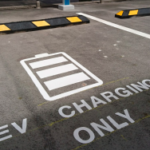For business fleets, changes to the tax regime make EVs and charging infrastructure far more attractive than petrol or diesel cars. Law firm TLT provides a succinct summary.
Law firm TLT installed EV chargers at its Bristol headquarters last year to meet rising staff and client demand.

Given the firm’s busy clean energy practice, it was also something TLT’s real estate and clean energy lead, Maria Connolly, was keen to do.
“When you’re regularly advising on projects as we are, there’s no better test case than doing it yourself,” says Connolly.
Meanwhile, changes to Benefit in Kind (BIK) rates for electric vehicles make EVs an increasingly attractive option for both staff and employers.
Company car tax breaks
The changes mean that the BIK for company car drivers is calculated by reference to a 0 per cent tax rate for this year, only 1 per cent for 2021-22 and 2 per cent for 2022-23.
Previously, the BIK regime applied a benefit value of 16 per cent of the car’s list price.
A £30,000 car would therefore be classed as generating a taxable benefit of £4,800.
So by taking an EV in the current tax year, employees effectively get a free car, which is still very cheap next year (taxable benefit of £300) and the following tax year (taxable benefit of £600) compared with a petrol or diesel equivalent.
“Government is using the tax regime to influence behaviours, and it is very favourable to EVs,” says Mark Braude, legal director in TLT’s tax team. The tax rules also allow employers to provide EV charging at work without generating a BIK, which means staff this year can get both a free car and free ‘fuel’.
Meanwhile employers can potentially claim capital allowances on the acquisition of an electric vehicle at a 100 per cent rate, says Braude.
Smooth ride
 Maria Connolly says the project implementation went very smoothly and TLT is now looking to install EV chargers across its national network of offices.
Maria Connolly says the project implementation went very smoothly and TLT is now looking to install EV chargers across its national network of offices.
“The Bristol office had sufficient grid capacity and we were able to draw on the technical capability of our clean energy team to ensure a smooth roll out,” says Connolly.
However, for companies considering switching to EVs, she suggests strong employee engagement and consideration of how charging will work in practice – in terms of numbers of cars, charging points and how that may need to be managed.
Accelerating growth
Outside of workplace charging, Maria Connolly says ‘destination charging’ within the retail, leisure and hospitality sectors, is growing rapidly.
After an initial land grab, those businesses are starting to think about how the provision of electric vehicle charging infrastructure can increase footfall and dwell time and enhance the user experience at the ‘destination’.
“The mix of charging infrastructure provided at a ‘destination’ needs to be designed with this in mind,” says Connolly. “For example, a mix of rapid and smart charging may suit retail parks and leisure outlets where dwell time will be longer. Whereas hospitality venues, particularly those where vehicles may be parked overnight, might benefit from smart charging, and supermarkets with shorter dwell times might favour rapid charging. It’s all about getting the right balance for the destination and the customer,” she adds. “As some of the big household names go live, this is going to be an interesting area to watch.”
Similarly, TLT has been involved in several partnerships between local authorities and private developers.
“It allows the local authority to meet its net zero goals and provide charging infrastructure without the capital cost,” she says.
“This is a potential growth area, particularly where the public-private model is utilised.”
App overload
As an EV driver, Connolly says one of main frustrations she faces is the plethora of apps required to overcome lack of interoperability across the UK’s charging networks.
However, charging networks have been tasked by government to ensure interoperability, and as of this spring, to allow ‘pay as you go’ card payments at rapid and higher powered chargepoints.
Meanwhile, providers such as Zap-Map are working with networks to allow drivers to use Zap-Pay to use any chargepoint.
Free report: EVs and charging infrastructure for businesses
To learn more about EVs, charging infrastructure, and how other businesses are tackling the road ahead, download your free copy of Good Energy’s latest EV white paper here.



